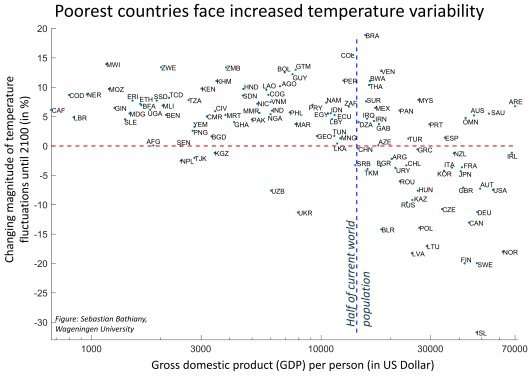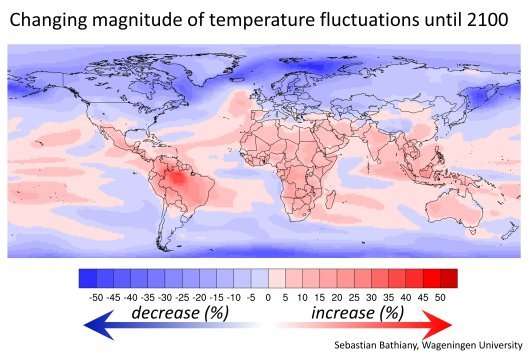Credit: Wageningen University & Research
It has been difficult to predict how weather extremes such as heat waves and cold snaps might change in a future climate. Now, a team of researchers from the Universities of Wageningen, Montpellier and Exeter revealed an unfair pattern. The research team found that rich countries that contributed most to climate change will see less temperature fluctuation, whereas in poor countries the fluctuations will become stronger.
While temperature variability is predicted to decrease outside of the tropics, it will increase in tropical countries – countries that are often too poor to deal with these changes. Temperature variability increases by up to ~15% per degree of global warming in Amazonia and Southern Africa, and by up to 10% /°C in the Sahel, India and South East Asia.
For their investigation the team analysed 37 different climate models that have been used for the last report of the Intergovernmental Panel on Climate Change (IPCC).
Climate injustice
The results point to a previously overlooked climate injustice. Sebastian Bathiany, lead author of the study, says: "The countries that have contributed least to climate change and have the least economic potential to cope with the impacts, are facing the largest increases in temperature variability." These increases are bad news for tropical societies and ecosystems that are not adapted to fluctuations outside of the typical range.
Relative change in standard deviation of monthly temperature anomalies until the end of the 21st century versus per capita GDP in different countries. The red line marks zero change in temperature variability. The blue line marks half of the current world population. Credit: Wageningen University & Research
The study also reveals that most of the increased temperature fluctuations in the tropics are associated with droughts, hence indicating challenges for food and water supply for many people. Prof. Marten Scheffer from Wageningen University & Research who is a co-author of the study points out: "The countries affected by this dual challenge of poverty and increasing variability already share half of the world's population, and population growth rates are particularly large in these countries."
Relative changes (%) of standard deviation of monthly temperature anomalies from pre-industrial conditions to the end of the 21st century, averaged over 37 climate models. Credit: Wageningen University & Research
Although climate variability has been studied extensively by climate scientists, the fact that climate variability is going to change has received little attention in fields investigating the impacts of climate change. The authors see their study as an opportunity to raise attention to this issue.
Credit: Wageningen University & Research
More information: Colin P. Morice et al. Quantifying uncertainties in global and regional temperature change using an ensemble of observational estimates: The HadCRUT4 data set, Journal of Geophysical Research: Atmospheres (2012). DOI: 10.1029/2011JD017187
Journal information: Journal of Geophysical Research - Atmospheres
Provided by Wageningen University


























